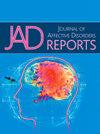经颅直流电刺激联合认知训练对老年抑郁症脑结构和网络同质性影响的初步研究
Q3 Psychology
引用次数: 0
摘要
在老年人中,抑郁症和认知能力下降经常并存。然而,有效的治疗选择仍然有限。神经调节已显示出超越传统认知训练的潜力;然而,它对大脑连通性和白质结构的具体影响尚不清楚。本研究的目的是评估经颅直流电刺激(tDCS)联合认知训练对老年认知缺陷伴抑郁症状患者白质微结构完整性和默认模式网络(DMN)同质性的影响。方法这项双盲、随机、假对照研究比较了认知训练联合正负或假性tDCS对老年抑郁症和认知能力下降的影响。在基线和治疗5周后,采用多模态磁共振成像评估DMN均匀性和白质微观结构。结果认知训练,无论是联合活动tDCS还是假tDCS,都显著增加了所有脑区的平均各向异性分数,表明白质完整性的总体改善。然而,tDCS对白质完整性没有额外的好处。较高的基线前后DMN关联与更好的认知功能相关,治疗缓解增加后DMN均匀性。扣带白质完整性的增强与抑郁症状、认知和脑源性神经营养因子水平的改善相关。结论认知训练可改善老年认知障碍和抑郁症患者脑白质完整性。扣带结构完整性的改变可以预测临床结果。没有观察到tDCS对白质完整性或网络均匀性的额外益处。本文章由计算机程序翻译,如有差异,请以英文原文为准。
Effect of combined transcranial direct current stimulation and cognitive training on brain microstructure and network homogeneity in late-life depression: a pilot study
Background
Depression and cognitive decline frequently coexist in older individuals. However, effective treatment options remain limited. Neuromodulation has shown potential beyond traditional cognitive training; however, its specific effects on brain connectivity and white matter structures remain unclear. The purpose of this study was to evaluate the effects of combining transcranial direct current stimulation (tDCS) with cognitive training on white matter microstructure integrity and default mode network (DMN) homogeneity in older adults with cognitive deficits and depressive symptoms.
Methods
This double-blind, randomized sham-controlled study compared cognitive training combined with either anodal or sham tDCS in older adults with late-life depression and cognitive decline. Multimodal magnetic resonance imaging was used to assess DMN homogeneity and white matter microstructure at baseline and after 5 weeks of treatment.
Results
Cognitive training, whether combined with active or sham tDCS, led to significantly increased fractional anisotropy averaged across all brain regions, indicating an overall improvement in white matter integrity. However, tDCS did not provide additional benefit to white matter integrity. A higher baseline anterior-posterior DMN association correlated with better cognitive function, and treatment remission increased posterior DMN homogeneity. Enhancements in cingulum white matter integrity were associated with improvements in depressive symptoms, cognition, and brain-derived neurotrophic factor levels.
Conclusions
Cognitive training leads to improved white matter integrity in older adults experiencing cognitive deficit and depression. Changes in the structural integrity of the cingulum can predict clinical outcomes. No additional benefits of tDCS on white matter integrity or network homogeneity were observed.
求助全文
通过发布文献求助,成功后即可免费获取论文全文。
去求助
来源期刊

Journal of Affective Disorders Reports
Psychology-Clinical Psychology
CiteScore
3.80
自引率
0.00%
发文量
137
审稿时长
134 days
 求助内容:
求助内容: 应助结果提醒方式:
应助结果提醒方式:


